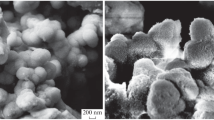Samples of electrodes with an active layer based on TiO2, RuO2, and rare-earth oxides (Ce2O3, La2O3, Nd2O3) doped with carbon nanoflakes were obtained. The morphology of oxide electrodes was investigated. Their electrochemical behavior in water solutions of sodium chloride and sulfate was studied. The values of the currentless potential, current density, and range of the potentials of chlorine- and oxygen-evolution from water solutions of sodium chloride and sodium sulfate were determined. Plots of the free-chlorine volume versus the composition of the electrodes are presented.






Similar content being viewed by others
References
V. A. Kolesnikov, V. T. Novikov, M. K. Isaev, et al., “Investigation of electrodes with an active layer of a mixture of the oxides TiO2, RuO2, SnO2,” Steklo Keram., No. 4, 26 – 32 (2018); V. A. Kolesnikov, V. T. Novikov, M. K. Isaev, et al., “Investigation of electrodes with an active layer of a mixture of the oxides TiO2, RuO2, SnO2,” Glass Ceram., 75(3 – 4), 148 – 153 (2018).
V. T. Novikov, A. V. Kolesnikov, M. K. Isaev, and L. A. Goncharova, “Study of oxide electrodes based on TiO2, RuO2, and SnO2 for electroflotation processes,” Gal’vanotekh. Obrab. Poverkh., 26(2), 50 – 56 (2018).
F. Liu, L. Ma, X. B. Li, and Y. G. Yan, “Study on the degradation of dye solution using Ti/IrO2–RuO2 electrode,” in: Proc. Intern. Conf. on Water Resources and Environment (2016), pp. 119 – 123.
C. Zhang, D. Tang, and X. Hu, “Scalable synthesis and excellent catalytic effect of hydrangea-like RuO2 mesoporous materials for lithium-02 batteries,” Energy Storage Mater., 2, 8 – 13 (2016).
O. V. Yarovaya, D. O. Lemeshev, U. L. Mostovaya, et al., “Production of flat ceramic membrane contactors with a catalytically active layer based on Co3O4,” Steklo Keram., No. 1, 20 – 23 (2016); O. V. Yarovaya, D. O. Lemeshev, U. L. Mostovaya, et al., “Production of flat ceramic membrane contactors with a catalytically active layer based on Co3O4,” Glass Ceram., 73(1 – 2), 19 – 21 (2016).
R. Otogawa, H. Shimizu, T. Inoue, et al., “Polarization behaviour and lifetime of IrO2–Ta2O5–SnO2/Ti anodes in p-phenolsulfonic acid solutions for tin plating,” J. Appl. Electrochem., 30(4), 511 – 514 (2000).
E. Horváth, J. Kristóf, R. L. Frost, et al., “Investigation of IrO2 /SnO2 thin film evolution by thermoanalytical and spectroscopic methods,” J. Thermal Anal. Calorim., 78(2), 687 – 695 (2004).
C. P. De Pauli and S. Trasatti, “Electrochemical surface characterization of IrO2 + SnO2 mixed oxide electrocatalysts,” J. Electroanalyt. Chem., 396(1 – 2), 161 – 168 (1995).
C. P. De Pauli and S. Trasatti, “Composite materials for electrocatalysis of O2 evolution: IrO2 + SnO2 in acid solution,” J. Electroanalyt. Chem., 538, 145 – 151 (2002).
X. Chen and G. Chen, “Stable Ti/RuO2–Sb2O5–SnO2 electrodes for O2 evolution,” Electrochim. Acta, 50(20), 4155 – 4159 (2005).
J. Ribeiro and A. R. De Andrade, “Characterization of RuO2 Ta2O5 coated titanium electrode microstructure, morphology, and electrochemical investigation,” J. Electrochem. Soc., 151(10), D106 – D112 (2004).
L. Du, J. Wu, and C. Hu, “Electrochemical oxidation of Rhodamine B on RuO2 – PdO – TiO2 /Ti electrode,” Electrochim. Acta, 68, 69 – 73 (2012).
X. Xu Wen, C. Zhen, and L. Fuping, “Advanced treatment of biologi-cally pre-treated coking wastewater by electrochemical oxidation using Ti/RuO2–IrO2 electrodes,” Chem. Technol. Biotechnol., No. 8, 1568 – 1575 (2013).
P. C. Deng, G., Wang, J. Z. Hu, and K. W. Tian, “Electrochemical depolymerization of chitosans using the IrO2 electrode with interlayers as anode,” Mater. Sci. Forum, 847, 281 – 286 (2016).
C. Hernandez-Mejia, E. S. Gnanakumar, A. Olivos-Suarez, and J. Gascon, “Ru/TiO2-catalysed hydrogenation of xylose: The role of the crystal structure of the support,” Catalysis Sci. Technol., 6, 577 – 582 (2016).
S. Cherevko, S. Geiger, O. Kasian, et al., “Oxygen and hydrogen evolution reactions on Ru, RuO2, Ir, and IrO2 thin film electrodes in acidic and alkaline electrolytes: A comparative study on activity and stability,” Catalysis Today, 262, 170 – 180 (2016).
E. Yu. Liberman, A. I. Mikhailichenko, T. N. Malysheva, et al., “Preparation and thermal stability of nanodisperse bicomponent materials in the system SnO2–CeO2,” Steklo Keram., No. 9, 18 – 21 (2017); E. Yu. Liberman, A. I. Mikhailichenko, T. N. Malysheva, et al., “Preparation and thermal stability of nanodisperse bicomponent materials in the system SnO2–CeO2,” Glass Ceram., 74(9 – 10), 319 – 322 (2017).
A. V. Tolstov, N. P. Pokhilenko, and N. Yu. Samsonov, “New possibilities of obtaining rare-earth elements from a single arctic source of raw materials,” Zh. Sib. Federal. Univ., No. 10(1), 125 – 138 (2017).
T. Audichon, S. Morisset, T. W. Napporn, et al., “Effect of adding CeO2 to RuO2–IrO2 mixed nanocatalysts: Activity towards the oxygen evolution reaction and stability in acidic media,” ChemElectroChem., 2(8), 1128 – 1137 (2015).
D. G. Lee and B.-H. Kim, “MnO2 decorated on electrospun carbon nanofiber/graphene composites as supercapacitor electrode materials,” Synthetic Met., 219, 115 – 123 (2016).
D Y.-H. Hsu, C.-C. Lai, C.-L. Ho, and C.-T. Lo, “Preparation of interconnected carbon nanofibers as electrodes for supercapacitors,” Electrochim. Acta, 127, 369 – 376 (2014).
D G. P. Ojha, B. Pant, S.-J. Park, et al., “Synthesis and characterization of reduced graphene oxide decorated with CeO2-doped MnO2 nanorods for supercapacitor applications,” J. Colloid Interface Sci., 494, 338 – 344 (2017).
This research was financed by the RFFI under the scientific project No. 18-29-24011.
Author information
Authors and Affiliations
Corresponding author
Additional information
Translated from Steklo i Keramika, No. 3, pp. 3 – 9, March, 2020.
Rights and permissions
About this article
Cite this article
Isaev, M.K., Goncharova, L.A., Kapustin, Y.I. et al. Physicochemical Properties of Oxide Coatings Based on Ruthenium, Titanium, and Rare-Earth Elements Doped with Carbon Nanomaterials. Glass Ceram 77, 81–86 (2020). https://doi.org/10.1007/s10717-020-00245-0
Published:
Issue Date:
DOI: https://doi.org/10.1007/s10717-020-00245-0



